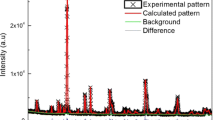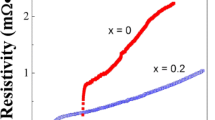Abstract
The Chevrel compounds Cu1.8Mo6S8−x O x have been studied, wherex=0.00, 0.05, and 0.10. In order to establish the effects of incorporating a small amount of oxygen into Cu1.8Mo6S8, we have measured lattice parameters, superconducting transition temperatureT c, and the temperature dependence of both the upper critical fieldH c2 and the magnetic susceptibility x. We show that the usual method of making this compound incorporates oxygen, and that this impurity may be removed by gettering the material with Y2S3. We observe that the substitution of oxygen for sulfur in Cu1.8Mo6S8 increasesT c and decreases the ratioc/a of the hexagonal lattice constants and x. A breakdown in the rigid-band approximation is indicated by a comparison of the relative signs of the effect onT c and that on x. In addition to these observations, we report on a correlation between hardness andT c of Cu1.8Mo6S8 and on the temperature dependence of the magnetic susceptibility of Cu3.2Mo6S8.
Similar content being viewed by others
References
K. Yvon, inCurrent Topics in Materials Science, Vol. 3, E. Kaldis, Ed. (North-Holland, Amsterdam, 1979), Chapter 2, p. 53.
Ø. Fischer,Appl. Phys. 16, 1 (1978).
R. Baillif, K. Yvon, R. Flukiger, and J. Muller,J. Low Temp. Phys. 37, 231 (1979).
R. Flükigeret al., Solid State Commun. 23, 699 (1977).
K. Yvon,Solid State Commun. 24, 41 (1977).
U. Poppe and H. Wühl,J. Low Temp. Phys. 43, 371 (1981).
F. Pobell, inTernary Superconductors, G. K. Shenoy, B. D. Dunlap, and F. Y. Fradin, eds. (North-Holland, New York, 1981), Chapter 3, p. 35.
K. Noto, S. Morohashi, and N. Kobayashi,Jpn. J. Appl. Phys. Part 1 21, 965 (1982).
V. V. Rao, G. Rangarajan, and R. Srinivasan,J. Phys. F 14, 973 (1984).
Z. H. Leeet al., Physica 107B, 297 (1981).
A. W. Webb and R. N. Shelton,J. Phys. F 8, 261 (1978).
K. Kitazawa, T. Matsuura, and S. Tanaka, inTernary Superconductors, G. K. Shenoy, B. D. Dunlap, and F. Y. Fradin, eds. (North-Holland, New York, 1981), p. 83.
V. Sankaranarayananet al., Cryogenics 22, 305 (1982).
V. Sankaranarayanan, G. Rangarajan, and R. Srinivasan,J. Phys. F 14, 691 (1984).
G. J. Dudley, K. Y. Cheung, and B. C. H. Steele,J. Solid State Chem. 32, 259 (1980).
A. M. Umarjiet al., Ternary Superconductors, G. K. Shenoy, B. D. Dunlap, and F. Y. Fradin, eds. (North-Holland, New York, 1981), p. 87.
D. G. Hinks, J. D. Jorgensen, and H. C. Li,Phys. Rev. Lett. 51, 1911 (1983).
D. G. Hinks, J. D. Jorgensen, and H. C. Li,Solid State Commun. 49, 51 (1984).
D. W. Caponeet al., Phys. Rev. B 29, 6375 (1984).
S. Foner, E. J. McNiff, Jr., and D. G. Hinks,Phys. Rev. B 31, 6108 (1985).
D. Guenzburgeret al., Phys. Rev. B 32, 4398 (1985).
A. M. Umarjiet al., Mat. Res. Bull. 15, 1025 (1980).
J. Bardeen, L. N. Cooper, and J. R. Schrieffer,Phys. Rev. 108, 1175 (1957).
B. T. Geilikman and V. Z. Kresin,Fiz. Tverd. Tela 1, 329 (1965) [Sov. Phys. Solid State 7, 2659 (1966)].
G. Bergmann and D. Rainer,Z. Phys. 263, 59 (1973).
B. Mitrovic, H. G. Zarate, and J. P. Carbotte,Phys. Rev. B 29, 184 (1984).
J. M. Coombes and J. P. Carbotte,J. Low Temp. Phys. 63, 431 (1986).
H. Nohl, W. Klose, and O. K. Andersen, inTopics in Current Physics, Vol. 32, Ø. Fischer and M. B. Maple, eds. (Springer, Berlin, 1982), p. 165.
W. H. Wright and D. M. Ginsberg,J. Low Temp. Phys. 64, 73 (1986).
W. M. Miller and D. M. Ginsberg,Phys. Rev. B 28, 3765 (1983).
R. Flükiger, R. Baillif, and E. Walker,Mat. Res. Bull. 13, 743 (1978).
F. Flükiger and R. Baillif, inTopics in Current Physics, Vol. 32, Ø. Fischer and M. B. Maple, eds. (Springer, Berlin, 1982), p. 113.
F. Fradin, J. W. Downey, and T. E. Klippert,Mat. Res. Bull. 11, 993 (1975).
R. Chevrel, M. Sergent, and Ø. Fischer,Mat. Res. Bull. 10, 1169 (1975).
Author information
Authors and Affiliations
Rights and permissions
About this article
Cite this article
Wright, W.H., Holmgren, D.J., Friedmann, T.A. et al. The effects of oxygen doping on copper Chevrel compounds. J Low Temp Phys 68, 109–123 (1987). https://doi.org/10.1007/BF00682624
Received:
Revised:
Issue Date:
DOI: https://doi.org/10.1007/BF00682624




